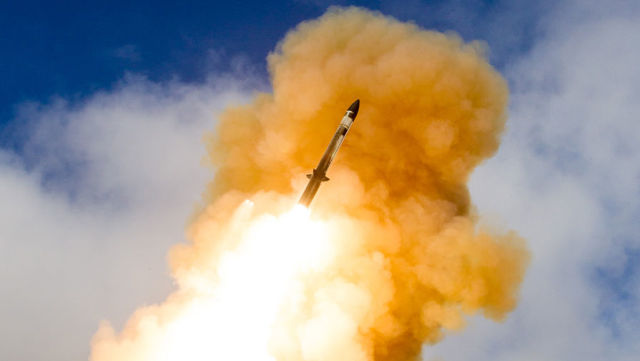In the United States tested the SM-3 to intercept Intercontinental missiles
The United States has successfully demonstrated the ability to destroy an Intercontinental ballistic missile using the Standard Missile-3 Block IIA anti-missile system. According to American experts, this test provides an opportunity to significantly improve the layered missile DEFENSE of the Americans and their allies. Is this so-in the material "Газеты.Ru".
According to the us missile defense Agency, a "threat" Intercontinental ballistic missile was launched from a test site on Kwajalein Atoll in the Marshall Islands at a target near Hawaii. Simulating the "defense of Hawaii" scenario, the us Navy destroyer John Finn, equipped with the Aegis ballistic missile defense system, successfully destroyed an ICBM using an SM-3 IIA interceptor. Defense News writes about the test.
The tests themselves were carried out at the request of the us Congress. Lawmakers explained the need for such a growing threat from the DPRK. Congressmen demanded to find out by the end of 2020 whether the US can use the sm-3 IIA interceptor to defeat Intercontinental ballistic missiles.
At the same time, North Korea has temporarily stopped flight testing of long-range Intercontinental ballistic missiles. However, Pyongyang continues to intensively develop land-and sea-based missiles. In particular, North Korea recently demonstrated its newest and largest ICBM to date, called the Hwasong-16. Flight tests of the missile are currently unknown, but Pyongyang currently has or is developing at least four other similar platforms - KN-08, KN-14, Hwasong-14 and Hwasong-15, writes DN. And each of them qualifies as an Intercontinental ballistic missile.
Given the Hwasong-16 ICBM presented, North Korea already has five types of missiles with an Intercontinental range, and some of them may well be used for nuclear missile attacks on the United States. That is why the SM-3 IIA anti-missile tests that have passed are quite important for us lawmakers.
Another threat that the us Congress implicitly implies is Iran, whose cooperation with North Korea in the missile field has been identified and already punished by the US government, American observers write.
Currently, Iran does not have Intercontinental ballistic missiles, and for its other products, Tehran has independently set a maximum firing range of 2000 km. But, as Iranian officials have said, the ban can easily be lifted unilaterally.
Tehran already has the largest Arsenal of short-and medium-range ballistic missiles in the middle East. According to the 2019 missile defense Review, Iran's desire to have a strategic counter to the United States could push it to deploy Intercontinental ballistic missiles, and progress in its space program could significantly shorten the path to a combat Intercontinental ballistic missile.
The first tier of the existing missile DEFENSE system in America includes a ground-based midcourse Defense system, which includes 44 ground-based interceptors in California and Alaska designed to destroy Intercontinental ballistic missiles in the interim. The third tier of missile DEFENSE includes the THAAD system (a mobile ground-based anti-missile system for high-altitude interception of medium-range missiles), which uses a high-potential locator to detect, track and then destroy them on the near approaches to defended objects.
SM-3 IIA anti-missiles deployed on URO destroyers (cruisers) or on land using the Aegis Ashore system can now give the United States another chance to destroy an approaching ICBM and play the role of an intermediate second-tier missile DEFENSE system.
The formation of another additional echelon of missile defense for the Americans is a common-sense action, but
However, defense News experts consider this argument rather dubious. The US missile DEFENSE system is designed to repel a" relatively modest " attack by North Korea and possibly Iran. Even with the long-awaited potential improvements associated with the SM-3 IIA anti-missile system, the US missile defense system remains completely inadequate against a massive nuclear missile attack from Russia or China.
The scale of such an attack by any country would easily overwhelm the US missile defense system. This is especially true given the hypersonic and cruise missile capabilities that both countries have or are developing, Defense News writes.
Instead of missile defense, Washington relies on its nuclear triad to deter a similar nuclear missile strike from Russia or China.
Russia and China know that America's existing missile defense and any upgrades that may be possible in the coming years using the SM-3 IIA will still not repel a massive nuclear missile strike, defense News writes. It is worth noting that Russia has more deployed missile DEFENSE systems than the United States, the publication States.
"SM-3 Block IIA is a version of the American anti-missile system with a new kinetic interceptor of increased size and new onboard equipment, with high capabilities for selecting false targets. The SM-3 Block IIA has an increased range and flight speed compared to previous versions. The flight speed of the product is up to 4.5 km / s, and the maximum target range is 2.7 thousand km. The product is designed to provide interception capabilities for Intercontinental ballistic missiles, " the Newspaper explained.Ru " ex-Deputy chief of the Main operational Department of the General staff of the Russian armed forces, Lieutenant General Valery Zaparenko.
However, according to the military commander, a promising American anti-missile system will be able to guarantee protection to a certain extent only from limited-scale missile attacks. And there are still no effective methods of protection against Russian planning hypersonic blocks of the Avangard rocket.
Mikhail Khodarenok

